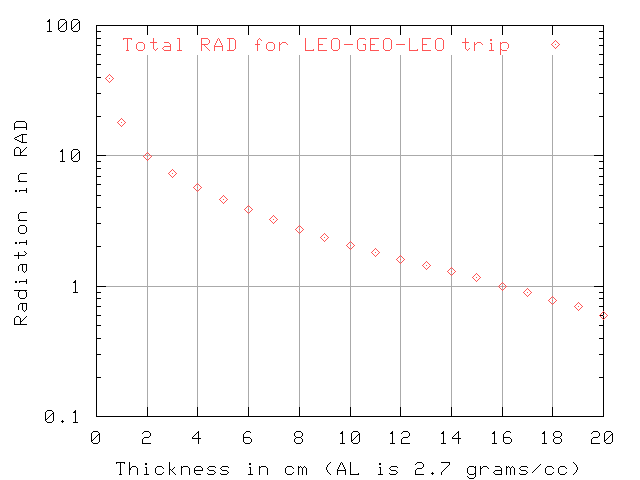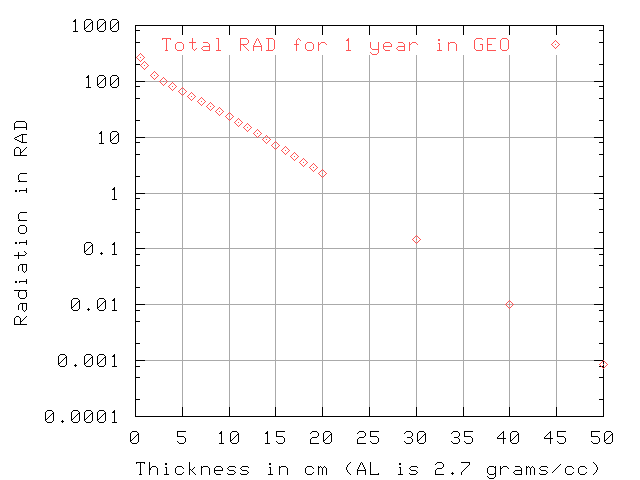
The ionizing radiation is usually thought of as high energy and high speed particles, though sometimes as very short wavelength waves. The particles can be photons, electrons, protons, and ionized elements, such as helium, iron, etc. The ionized elements have been stripped of their electrons.
When these high speed particles pass through matter they can do damage, possibly deep inside the matter. As they go through they leave a trail of ionized (missing some electrons) particles behind them. The number of ionized particles per cm of path depends on the type of particle and its velocity. A bigger and higher speed particle will do more damage.
The ionizing radiation near Earth comes from our Sun and also distant parts of the Universe.
So we, like most people, will only worry about absorbed radiation dosage terms. This looks at how much radiation energy is absorbed per Kg of mass. Absorbed radiation dosage starts out as a single simple number. While it soon gets more a bit more complicated, it is still much simplier than dealing with flux information.
There is radiation dose, and then biological equivalent dose. The biological equivalent takes into account a relative biological effectiveness (RBE) factor indicating how damaging that type of radiation is to humans. In this table, all terms in one column are for equal dosages. For example, 1 Gray equals 100 rad. The right column is biological equivalent dose and the left is the base radiation dosage. The two columns are equal if the quality factor is 1. For example, on-board MIR they measured a 1.9 RBE, and 0.32 mGy/day. Multiply these together and you get 0.61 mSv/day [Eckart1996, page 51]. The RBE is also called the quality factor.
| Radiation Dose (all equal) | Biological Equivalent Dose (all equal) |
| 1 Gray (Gy) | 1 Sievert (Sv) |
| 100 rad | 100 rem |
| 1000 mGy | 1000 mSv |
| 1 Joule/Kg | 100 cSv |
| 10000 ergs/gram |
The next complication is that different parts of your body can tolerate different amounts of radiation. On top of this, each part of your body is shielded by the rest of your body, in differing amounts. When talking about career limits for radiation exposure, the BFO (blood forming organ) dosage at 5 cm depth is used. People use the attenuation of 5 cm of water shielding to get this number (as flesh is mostly water).
The next table comes from [NCRP, 1996, page 55] which got it from a 1970 NRC report. So this is an older standard.
| Name | Bone Marrow (also BFO) | Skin | Ocular Lens | Testes |
| Depth | 5 cm | 0.1 mm | 3 mm | 3 mm |
| 30 day max | 25 rem | 75 rem | 37 rem | 13 rem |
| Quarter max | 35 rem | 105 rem | 52 rem | 18 rem |
| Year max | 75 rem | 225 rem | 112 rem | 38 rem |
| Career max | 400 rem | 1,200 rem | 600 rem | 200 rem |
Note that your skin can tolerate 3 times the rem that your bone marrow can. If the 5 cm of flesh shielding were to reduce the radiation by a factor of 3, then both your skin and BFO could be at their limits under the same radiation exposure.
| Agency | Category | Basis | Limit |
| NASA | Astronaut - BFO | 3% excess cancer mortality | 25 rem/month |
| NASA | Astronaut - BFO | 3% excess cancer mortality | 50 rem/year |
| NASA | Astronaut - BFO | 3% excess cancer mortality | 100 to 400 rem/career |
| US Government | Radiation worker | 1% excess cancer mortality | 5 rem/year |
| US Government | General population | Small risk/children/fetuses | 0.5 rem/year |
| Measured | Radiation |
| Jet airplane crew | 0.3 to 0.6 rem/year |
| Worldwide Average | 0.24 rem/year |
| Apollo 7 mission (lowest radiation) | 0.40 rem total |
| Apollo 14 mission (highest radiation) | 2.85 rem total |
The Sv in the reference have been converted to REM here.
| Effective Dose in REM | ||
| Age | Female | Male |
| 25 | 25 | 40 |
| 35 | 50 | 70 |
| 45 | 60 | 100 |
| 55 | 80 | 150 |
We estimate that a week in space will costs $50,000/person. Most people who can afford this will be over 45 years old. So the higher age limits, which have larger REM values, are probably more applicable. For a 1 week trip we probably want to be like 1/20th of the career limit. So if we use a 55+ year old male (probable customer profile) then we probably want to keep under 7.5 BFO-rem and 22.5 skin-rem for the trip.
Shielding for cosmic radiation is hard because it is such high energy particles. The radiation from cosmic radiation can penetrate meters of shielding. Fortunately, the level is low enough that it is not a problem for a short trip. However, cosmic radiation could be a significant problem for long term staff (more than a couple years). Shielding at the hotel will have to be designed with them in mind.
For Solar Particle Events (SPE) people would need significant radiation shielding. A space hotel will probably have significant shielding anyway, in order to be safe from the outer Van Allen belt and Cosmic radiation. However, if the whole hotel is not sufficiently shielded, there could be radiation shelters for people to go to.
The capsule will not have as much shielding as the hotel. Fortunately, there is some warning before a SPE. So if you can tell a SPE is on the way, or even that there is a high risk of SPE, you could decide not to launch the rocket. The time from when the rocket launches till when the capsule gets to the hotel in geosyncronous Earth orbit (GEO) will only be about 4 hours. So 4 hours would be enough warning.
A method has been proposed to use a tether to reduce the radiation in the Van Allen Belts to maybe 1% of its natural level. This could be a very worthwhile thing, if many people are going into space.
Radiation doses on the Apollo mission ranged from a minimum on Apollo 7 of about 0.40 rem to a maximum on Apollo 14 of about 2.85 rem. At first it would seem that since Apollo astronauts went through the Val Allen Belts twice and stayed under the legal limit for radiation workers that we could. However, it turns out that Apollo went through the very edge of the Van Allen Belts and that is why they got very little radiation. Apollo missions left LEO heading for the moon when radiation belts were 11 degrees South and they were about 28.5 degrees North, thus missing most of the radiation [Langton1969, page 134]. For a toss from a LEO-tether to a GEO-tether where both are over the equator we will go through near the middle of the Van Allen Belts.
Detailed simulation and examination of the radiation problem is possible with the SPENVIS - SPace ENVironment Information System web applet. It is possible to specify a level of shielding and a trajectory for the spacecraft and find out how much radiation would get inside the spacecraft. This applet uses MULASSIS - MUlti-LAyered Shielding SImulation Software which in turn uses GEANT4 which is a toolkit for the simulation of the passage of particles through matter.
To convert the RAD numbers in the graph to BFO REM numbers we would need to know
two things we have not found yet.
The first is how much the 5 cm of flesh (or water) will reduce this radiation.
It is probably substantial, as water is a good shielding material.
The second is the average quality factor. In
one source for Apollo 14 they
used a quality factor of 2.5 but I am not sure what it should be
in this case. In [Johnston1969] they show Apollo 14
had 1.14 rad for skin, which was the highest of the Apollo missions.


Aluminum is about 2.7 grams per cubic cm. If you have a 20 cm thick Aluminum shield, then you have 54 grams/sq-cm or 540 kg/sq-meter. This, or even more, would not be too bad for a hotel, once prices to orbit were cheap. So it seems very reasonable to shield the hotel against the Van Allen belt radiation even for employees staying for years. The Cosmic radiation is another question. But in any case, a short tourist visit for a week will not be a problem.
However, you would not want to lift 540 kg/sq-meter shielding for the capsule each launch. For the capsule you could have the shielding cycle between LEO and GEO and never land. The capsule with the tourists would join with the shielding somehow. This would mean the tethers would have to be stronger, but it would not take any more energy to operate. Also, with 11 people they could be arranged standing in a circle shoulder to shoulder so that they all shield each other. So the actual dose could be less than indicated by the graphs. It seems that radiation is a manageable problem for a tourists visiting for a week.
If the capsule pilots are flying through the Van Allen Belts on a regular basis, then they could have a radiation problem. It would probably be necessary to rotate a large number of people through pilot duty. These same people could be regular staff at the hotel. It seems that getting volunteers to fly a trip to a space hotel would not be hard, even if they had to work while they were there.
There are pills that can be taken to reduce the effects of radiation. For example, APAETF (aminopropyl-aminoethyl thiophosphoric acid) has a dose reduction factor of 3. Thus you could stay three times as long for the same total effect. Either tourist or long term staff could take such medicine.
There is a level of risk tolerated by society for both work and play.
Click for SpaceTethers.com
Copyright (c) 2002, 2003 by Vincent Cate. All rights reserved.